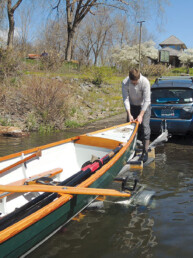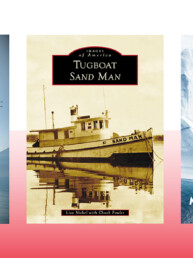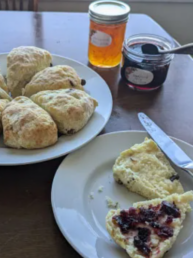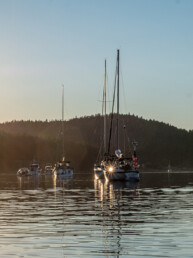
In January 2016, Swedish couple Johan Hammarlund and Malin Löf set sail on their 1987 custom-built Beason aluminum sailboat, RAN. After cruising through Alaska in the summer of 2018, the YouTube vloggers made their way to Seattle and stopped at the Corinthian Yacht Club for a presentation earlier this month.
Local sailor and writer Jennifer Bost was in the audience and captured the Q&A portion of the evening.
Q: Earlier in the year, you (Malin) had a medical scare when something happened to your foot. How’s it feeling? Everything OK?
A: Yes, the accident actually didn’t happen on RAN. We spent Christmas on a friend’s boat, a Swan 60-foot, and when I was up on deck a large lazarette locker fell on my foot. We had to sail for six hours to another island to find a doctor, but he came aboard and stitched me. And we were able to find crutches on the island. It took about six weeks for it to heal.
Q: Do you have any advice or words of wisdom for someone planning what you’re doing?
A: It’s hard to say, really. Budgets are hard to compare. It’s easy to buy a boat. But you need to ask yourself if you can afford to maintain it. Keep it in good shape. There’s a big difference between a 35-foot and 5o-foot boat, and with offshore sailing. Small can be safer if it’s well-maintained.
Q: Have you ever been worried about pirates?
A: No, not really. There have been a few places where we’ve been more cautious. Curaçao, Venezuela to Aruba — problems with opportunistic fishermen. Looking to steal something. We didn’t have a problem, but we were more watchful.
Honduras is another. There’s very shallow water there and speed boats can travel far away from shore. Some attacks have been reported. Trinidad. Windward Island. St. Vincent. Grenadines.
Cruisers talk to each other, so that’s how we get to know what’s up.
Q: With all your travels, what were the worst conditions you sailed in?
A: Probably the Canary Islands. Between the island they have acceleration zones. Wind can go from 10 to 40 knots within seconds. Summer is when these are the strongest, which is when we were there. At one point we hit 45 knots. At the same time, we had another problem. We had a gas leak from our small barbecue grill. A swim flipper had landed on the regulator and emptied all the gas into the boat. So we had big waves crashing over the boat, 45-knot winds, and all our windows were to open to air out the gas. Saltwater was all over the place. It was a mess.

Q: When are you writing a book?
A: I (Johan) am actually working on a book. It’s about 400 pages now. It’s not about this trip, but about my Antarctica trip.
Q: How do you get potable water? Do you have a watermaker onboard?
A: We left Sweden without a watermaker. But we did pick one up when we were down in the Caribbean. We installed a Cruise RO watermaker. Really, it’s for when we go to the South Pacific. It will be easier to sail there with a watermaker, because water is harder to find. It’s also easier. You can get strong arms from carrying water, but it is nice to always have it onboard.
Q: Do you have any location limitations with your insurance? Some companies drive people out of the Caribbean every winter now because of the 2017 hurricane season (Irma and Maria). They’ve changed their insurance policies if you want to be insured.
A: Yes, we’ve heard such things. For our insurance company, we make up an itinerary every year and give it to them. Then they give us an estimate. We are allowed to be in hurricane areas, but our insurance will go up five times our current rate if something were to happen to RAN.
Q: What’s the weirdest animal you’ve seen on your travels?
A: Probably sea cows (manatees) in Puerto Rico. Oh, and we love the sea otters in Alaska.
Q: What’s your finance plan/budget?
A: Johan worked for the Bosch tool company back in Sweden. He brought all his tools with him for shore work, if needed. We also saved up two to three years of spending before we left Sweden. And YouTube helps keep us sailing. On average, we spend about $2,200 per month.
Q: Do you film constantly and then edit? Like you got these humpback whales on film, which are impossible to catch on video. How do you do it?
A: No, we don’t. It was easy to film in Alaska. There was something to see everywhere. We keep our camera close on hand. And we plan. What can we do? What would be nice? But there are many days we don’t film.
Q: How long does it take to make one video?
A: Oh, that has changed. It took much longer when I (Malin) was first getting started. I hadn’t done much video editing before. But I enjoy it. Photography and video editing. Now it takes 15 to 25 hours per episode.
Q: Do you have health insurance?
A: When we left Sweden we didn’t, because we were in the EU and had universal coverage through our social security system. After crossing the Atlantic, we got it. Medical insurance is dependent on the country you’re from. Insurance is tied to that system. If we were to get sick, insurance would cover our staying in a hospital wherever we are until we were stable, and then they’d fly us home if we needed long-term care.
But when Malin hurt her foot in Caribbean we didn’t deal with insurance. The doctor’s bill only cost us $180 out of pocket.
Q: What were your favorite places north of Seattle?
A: Desolation Sound has lots of great coves and islands. Up by Vancouver we stopped at Texada Island, the Gulf Islands … Salt Spring Island, Sidney Spit, Portland Island. Bishop Bay — loved the hot springs and humpback whales there. Prince Rupert was great for downwind sailing. We liked the San Juan Islands … Sucia Island.
Q: What’s been your favorite place so far?
A: Cape Verde Island outside of Africa. I visited there 10 years ago when I sailed Antarctica. Now it feels safer. It was nice to see the huge progress and to cruise those islands.
Q: What’s your least favorite place?
A: Colon, Panama. It’s a sad place. Terrible. Panama is strange. The west coast is fancy cities, and on the east coast people are dying from buildings crashing down.
Q: Do you feel pressure to keep sailing because of your YouTube audience?
A: No, we like to experience the world. If we get to that point, we’ll stop.
Q: What percentage of time have you actually sailed on this trip versus motoring?
A: We like the lifestyle of liveaboard cruising. We’re not racers. We like to spend time and not rush through places. This year we sailed 11,000 nautical miles. That’s three months at sea, in total, at the end of the year. But with the Inside Passage, yeah, we were motoring 80 percent of that time. I’d (Johan) say we spent 600 miles motoring and the rest sailing out of those 11,000 nautical miles.
Q: What’s your favorite culture in the countries you’ve visited?
A: That’s what we like most about traveling — to see how people live. To experience their culture. I (Malin) would say the native people of Guna Yala in Panama were my favorite. They have their own territory and live in sugar cane huts with small solar panels for some electricity. But they traditionally cook over a fire. And they make jewelry with beads, and they weave their own textiles. So interesting.
Q: Is there anything you would have done different before leaving?
A: No, I don’t think so. We could have done more with the boat. We left in winter, because Johan had taken on a new job that was terrible. He really hated it. But we couldn’t just leave after getting the new jobs, so we ended up leaving after one year there. We could have spent more time at home fixing up the boat for this journey. But we didn’t want to spend more money just living at home, and we can always fix the boat along the way. So we decided to just go.
Q: What’s your favorite thing about RAN? And what’s a bad thing?
A: She’s fast. She sails good. We can go 200 nautical miles in 24 hours. For bad, because she sails good there’s not much storage. She was built for racing, which is why she has two cockpits. That means not as much room inside the boat.
Q: What items were you convinced you needed but haven’t used?
A: Probably too many clothes and shoes. Oh, and tools. Because of his previous job, Johan has enough tools to build a whole boat with. Big tools, too. Big saws and stuff. We also left with a lot of books, but then we got rid of books for Kindles.
Q: What on RAN brings you the most comfort? Like a home.
A: She’s been our home for four years now. We have everything we need. But if we didn’t have a real shower I would probably miss that.
Q: Where to next? Is Seattle your final destination?
A: We’re in Seattle for the winter fixing up the boat. There’ work to do on the chain locker and we need to service our engine. But we’re looking forward to flying back home to Sweden to spend time with our friends and family. We’ll be back in January for more boat work — haul out. And then we’ll head south along the West Coast to California and Mexico, and then to the South Pacific.






